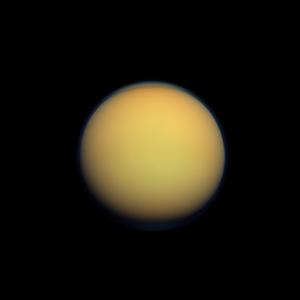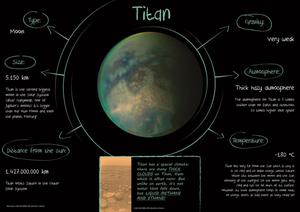Glossary term: 泰坦
Description: 土卫六(泰坦)是土星最大的卫星。它比月球和水星都大,是太阳系中第二大的卫星。除地球外,土卫六是唯一已知表面有液态大洋、海和河流的天体。不过,这些都是由被称为碳氢化合物的化学物质构成的。土卫六被认为有一个岩石核心和一个由水构成的冰壳。人们认为冰壳下的液态水可能孕育着生命。土卫六的大气层很厚,主要由氮气构成,这使得它在照片上看起来非常光滑。
Related Terms:
See this term in other languages
Term and definition status: The original definition of this term in English have been approved by a research astronomer and a teacher The translation of this term and its definition is still awaiting approval
The OAE Multilingual Glossary is a project of the IAU Office of Astronomy for Education (OAE) in collaboration with the IAU Office of Astronomy Outreach (OAO). The terms and definitions were chosen, written and reviewed by a collective effort from the OAE, the OAE Centers and Nodes, the OAE National Astronomy Education Coordinators (NAECs) and other volunteers. You can find a full list of credits here. All glossary terms and their definitions are released under a Creative Commons CC BY-4.0 license and should be credited to "IAU OAE".
If you notice a factual or translation error in this glossary term or definition then please get in touch.
Related Media
土卫六自然色彩图像
Credit: 美国宇航局/喷气推进实验室/空间科学研究所 credit link
License: PD Public Domain icons
具有表面特征的土卫六
Credit: 美国宇航局 / 喷气推进实验室 / 亚利桑那大学 / 爱达荷大学 credit link
License: PD Public Domain icons
Related Activities
Children's Planetary Maps: Titan
astroEDU educational activity (links to astroEDU website) Description: Learn about the only other known body in the Solar System with Seas and Lakes
License: CC-BY-4.0 Creative Commons 署名 4.0 国际 (CC BY 4.0) icons
Tags:
Maps
, Planetary cartography
, Spatial thinking
Age Ranges:
6-8
, 8-10
, 10-12
Education Level:
Middle School
, Primary
, Secondary
Areas of Learning:
Social Research
Costs:
Low Cost
Duration:
2 hours
Group Size:
Group
Skills:
Analysing and interpreting data
, Asking questions
, Communicating information
, Constructing explanations
, Developing and using models
, Engaging in argument from evidence
, Planning and carrying out investigations











